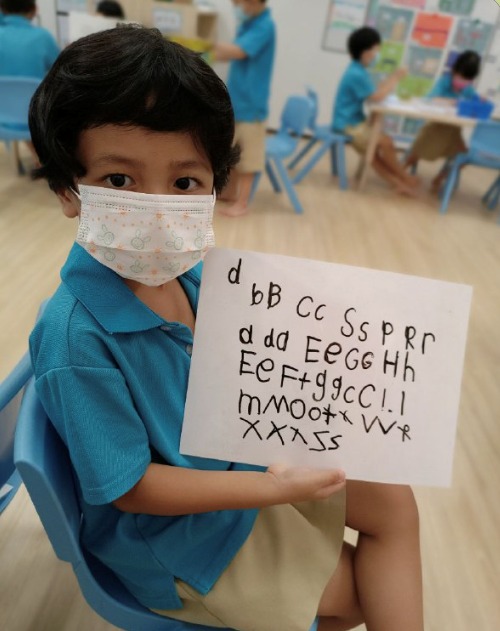Effective Communication with Young Children
20 Dec 2012

“We do not teach English, Maths or Science; we teach children,” Mrs Polly Low reminded the teachers, citing Dr Ruth Wong, a pioneer in Singapore’s education field.
At the workshop “Effective Communication with Young Children” on 20 November 2012, Mrs Polly Low from the Association for Early Childhood Educators (Singapore) gave each kindergarten teacher a sheet of paper and said, “For this activity, there are some rules. I am going to read out the instructions and you need to listen. Do not ask me any questions. Do as you are instructed. When you are finished, you can show your product to me.”
The teachers followed her directions to the letter, drawing a series of circles and lines. The results, however, were a meaningless jumble – a far cry from the desired goal, a sketch of a songbird. “Tell me, how did you feel when I was reading out the instructions?” asked Mrs Low. “What was wrong with what I said?”
The participants piped up with many reasons: “the instructions weren’t clear”, “they were not specific enough”, “we were not allowed to ask questions” – to which Mrs Low replied in jest, “That was a negative demonstration. I am a lousy communicator!”
This scenario illustrated the importance of the recommendations Mrs Low discussed at the workshop, which was held at the MOE Kindergarten Learning Forum 2012. Emphasising the impact that pre-school teachers have on the social and emotional development of their young charges, she encouraged them to develop a keen awareness of a child’s state of mind and the ability to manage children’s emotions in a supportive manner.
Body language and barriers to communication
“Young children share very readily and I think that’s very beautiful,” said Mrs Low. “They are very forthcoming – things just flow out of their mouths, their hearts and their minds.” Teachers, therefore, have to learn to “see the beauty in children” and not put a lid on their natural desire to communicate and express themselves.
Communication is not just verbal. “A message can be more than words,” noted Mrs Low. “It can be a smile, a gesture.” A withdrawn child might be encouraged by a brief but warm gaze from his favourite teacher.
Adults should bear in mind that children often use physical contact to show their affection. One child, she recalled, was fond of touching her teacher’s leg, which made the teacher feel very ticklish. Instead of responding with a disgusted look or harsh words, a possible response would be to gently ask why the child did that and explain that such gestures made the teacher uncomfortable and may not be appropriate. “It’s an opportunity to teach the child social skills,” explained Mrs Low.
Mrs Low shared that barriers to communication could be physical, such as a hearing impediment or extraneous noise, or psychological. Children might not pay close attention because of fear, such as when a teacher uses a stern tone, or because they are mentally preoccupied. Mrs Low recounted the case of a girl who was always dozing off in class. The teacher initially wondered if it was because her lessons were boring, but later learned that the child’s parents often worked late and delayed her bedtime. “By the time she reached school, she was very tired and often fell asleep.”

The ability to listen and observe, and respond accordingly, is part of effective communication skills, according to Mrs Low.
Helping children communicate and learn
Children today are less inhibited than those in the past. “I’d sit quietly and do what the teacher says,” recalled Mrs Low of her student days. “Today’s child wants to know. They are curious, they ask you questions, and that’s a very good sign. If a child sits there quietly, I’d be worried.”
In this light, teachers cannot merely dispense knowledge, but should act a “co-constructors” who guide a child to form his or her own ideas and understanding of a lesson. “When we ask a child questions, give them time to think and respond,” she suggested. “Use short phrases, simple words and open-ended questions like ‘what would happen if …?’, ‘tell me what it looks like …’ or ‘what do you think about …'” Teachers as well as parents can thus help create an environment in which children feel welcome and eager to take part in lessons.
As for what parents can do at home, Mrs Low said the most important aspect, in her opinion, is “to provide more emotional support.” Parents, she added, “need to give more affirmation to their children and appreciate their child for who they are.” A positive emotional connection between parents and child goes a long way towards strengthening communication between them.
Effective communication, she added, is also vital between parents and pre-schools, so that both parties know how a child is developing and whether he or she has any problems learning or communicating. A child may, for instance, lose interest in class when a new baby is coming at home, as he or she feels left out. “The child’s mind is preoccupied with whether his or her parents still loves him or her,” explained Mrs Low. “In this case, the parent could give more emotional support to the child.” This could be supported by teachers in the child’s pre-school environment too.
“Every child is special and unique,” highlighted Mrs Low as she shared her personal thoughts on parenting and communication. “Each and every child has a gift within him- or herself, and it’s up to us adults to be able to identify and appreciate it.” This would then enable parents – and teachers – to more effectively encourage children to develop those gifts together with their cognitive thinking and social skills.



.jpg)
.jpg)
.jpg)
